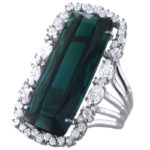There are dozens of possibilities for engagement ring settings. Learn the basics about all of your options to make the right decisions before selecting an engagement ring of your dreams.
Engagement Ring Settings: Learn the Basics
Channel Setting
Diamonds or gemstones set in a channel setting are secured in place side by side, lined up along a groove, or channel, in the metal. This type of setting is used for smaller stones that are lined up along the ring band.
For example, the Michael M Three Stone Engagement Ring features superb channel set diamonds along the glittering shank.
Pros:
- No prongs for snagging
Bar Setting
Similar to channel settings, bar settings are based on the same concept of holding the gems in place with the sides of a grove. The difference is that only two sides are held in place by the channel, whereas the other two sides are held by metal bars.
Pavé Setting
Pavé comes from the French word for pave. The ring band is literally paved with gems.
The jeweller drills holes into the ring itself and secures the gems in the cavities, crafting tiny prongs to hold them firmly in place. Because of this technique, the gems can be positioned so closely to one another that the prongs are barely visible and the band appears as one glittering mass of jewels.
Take a look at the Hearts on Fire Lorelei Pavé Engagement Ring to see a stunning example of pavé setting.
Pros:
- Achieves a line of unbroken sparkle, since the gems are placed so closely together
- Accentuates the centrepiece stone
Cons:
- Difficult to resize after the ring has been completed
Eternity Setting
Eternity ring settings are not engagement ring settings per se, but rather eternity is a style. They were the first rings to emerge on the market that did not exhibit a main center stone, but rather, a continuous, unbroken circle of identical stones.
The idea behind the eternity setting (also called an infinity setting) is that the love of the couple is unbroken, unchanging, and never ending.
Some couples assign a meaning to each gem in the eternity setting. For example, one gem symbolizes the day they met; another, the day of their engagement; another, the day of their wedding promises, etc.
Eternity rings are also traditional gifts from a husband to his wife on their first wedding anniversary.
Examples of exquisite rings with eternity settings are Katharine James Juliet’s Love® and Michael M Everyday Luxury Wedding Ring.
Pros:
- Deeply meaningful and symbolic
- Suitable as an engagement ring, wedding ring, or anniversary gift
- Rooted in a beautiful tradition
Prong Setting
How to eliminate as much surrounding metal as possible to allow as much light as possible to pass through the gem, bringing out its full radiant potential? The answer is a prong setting.
Prongs are minimal pieces of metal that hold the gem in place like tiny but firm little claws.
In the Bernie Robbins White Gold Engagement Ring, both of the smaller diamonds along the shank and the large center diamond are held in place by finely wrought, miniscule prongs. By contrast, the Hearts On Fire Atlantico Pave Engagement Ring features a combination of two different gem settings, the pavé setting for the shank and the four prong setting for the center diamond.
Pros:
- Allows maximum refraction of light
- Brings out the gem’s fullest potential
- Gets the most sparkle
Cons:
- If not well made, prongs are notorious for snagging- only choose high quality prongs
Tiffany Setting
A variation of the prong setting technique, the Tiffany setting was developed and trademarked by Tiffany & Co. in 1886. It has been scientifically proven that this intricate six-prong design lets more light into the gem and enhances natural reflection and refraction.
Bezel Setting
Second only to prongs, bezel settings are one of the most popular methods of holding a gem in place on an engagement ring. A bezel setting completely encircles the gem with overlaying metal, keeping it snug and low against the band.
Deciding between prong and bezel engagement ring settings is largely a matter of lifestyle. A protruding prong-held diamond ring may be at risk in some job settings, but a bezel setting will protect the diamond and keep it safe from falling out or getting damaged. It will also ensure against the diamond snagging, scratching, or getting caught on materials or surfaces.
Although bezel settings prevent some of the light from coming through, and can cover up to 10% of the gem’s surface, they have been popular since the late 1800’s and have acquired a classic grace and beauty. They have recently had a comeback in fashion due to their sleek, smooth, uncomplicated look.
Pros:
- Protects the gem
- Prevents snagging and scratching
- Vintage class and elegance
- Coming back in popularity due to their sleek modern feel
Cons:
- 10% of the gem surface hidden by the surrounding metal
- Light is prevented from entering on the underside of the gem
Tension Setting
As suggested by its name, a tension setting holds the gem in place by exerting tension on it from surrounding pieces of metal. This results in the unique impression of the gem appearing to be suspended. Tension setting first came out in the 1970’s, so many people consider them contemporary and modern.
Halo Setting
A halo setting is a circle or square of gems around the centerpiece, usually paved or micro-paved (paved with gems less than .01 carats). The purpose of a halo setting is to make the center jewel appear larger and more sumptuous. Given that the refraction of light is now more than doubled, it certainly achieves that effect!
The Hearts On Fire Transcend Premier HOF Halo is an example of a circular halo setting. The Verragio Insignia Engagement Ring is an example of a square halo setting. The shape of the halo will depend on the cut of the center gemstone.
As can be guessed from the name, a double halo setting is two circles or squares of gems around the centerpiece, and a triple halo setting is three.
Halo settings have been traditionally used for centuries, so besides their value of enhancing the main gem, they offer a classic, vintage look.
Pros:
- Less expensive than a larger carat center gem, but the same brilliance and sparkle
- Vintage appeal
Flush Setting
Creating a flush setting involves drilling a hole into the ring band and setting the gem directly into the hole. The surface of the gem must level with the surface of the band. The jeweller then hammers the surrounding metal firmly into place around the gem.
Flush settings are particularly sought after in men’s rings. The smoothness of the resulting appearance makes them seem especially masculine to some people, and the protection to the gem offered by the setting makes them easy to care for.
Cathedral Setting
The term cathedral setting refers to any setting that raises the gem higher on cathedral-like arches.
A dazzling example of the cathedral setting is the Katharine James Juliet’s Love® Open Fleur De Lis, with its dramatic and beautifully decorated prongs holding the center diamond.
The defining feature of the cathedral setting is the arches above the shank. The method of holding the gem into place can be prongs, bezel, or tension.
Solitaire Setting
The solitaire is not technically one of the many engagement sing settings, but it refers to a ring style that has a single gem.
Solitaire settings can look graceful and elegant. The lone center jewel has the stage all to itself, while the soft, gleaming gold of the shank is bare and visible. Solitaire rings have been the go-to style of standard engagement ring settings for hundreds of years.
Beautiful rings with solitaire settings are Gabriel & Co. Bridal Polished Criss Cross and the Hearts On Fire Lorelei Triple Row Solitaire.
Pros:
- Historically standard engagement ring for generations
- Timelessly popular, even today
- Gives more attention to the detailing of the gold band
Side Stone Setting
A side stone setting is a design that enhances the center gem by placing complementing gems on either side.
Side stone settings can make magnificent centerpieces. Take, for example, the Scott Kay Ladies White Gold Heavens Gates, which presents a large middle diamond with two smaller diamonds on either side, each mounted with prongs.
Or the Hearts On Fire Beloved Three Stone Engagement Ring, giving new meaning to the term “centerpiece” with three central diamonds, each surrounded by its own circular halo.
Three Stone Setting
A variation of the side stone setting, the three stone setting has been given special significance.
The triple centerpiece gems, placed beside one another, are said to represent the past, the present, and the future shared by the couple.
Antique Setting
This refers to any retro or vintage engagement ring setting of a specific era, such as the Victorian era. Antique settings are often embellished with fine filigree and other intricate details.
Cluster Setting
A cluster setting is any setting which groups many gems close together so they appear as one. Cluster settings include halo settings, which enhance a centerpiece by completely encircling it will many smaller gems.
Split Shank Setting
A split shank setting is a design that splits the ring band into two, three, or more parts.
The Hearts On Fire Envelop Twist Engagement Ring is a splendid example of a split shank setting. The diamond-decorated band is divided into two parts that twist around each other in an imaginative and playful pattern.
Make an informed choice when shopping for engagement ring settings
This information should help you make an informed decision regarding what will be the most important symbolic material possession that you will ever receive. Explore the various engagement ring settings and consider their pros and cons so you can choose the perfect ring for your style and your life!





















Danielle
November 11, 2016 at 10:55 pmI’m a fan of the classic engagement ring settings. I love the traditional look.